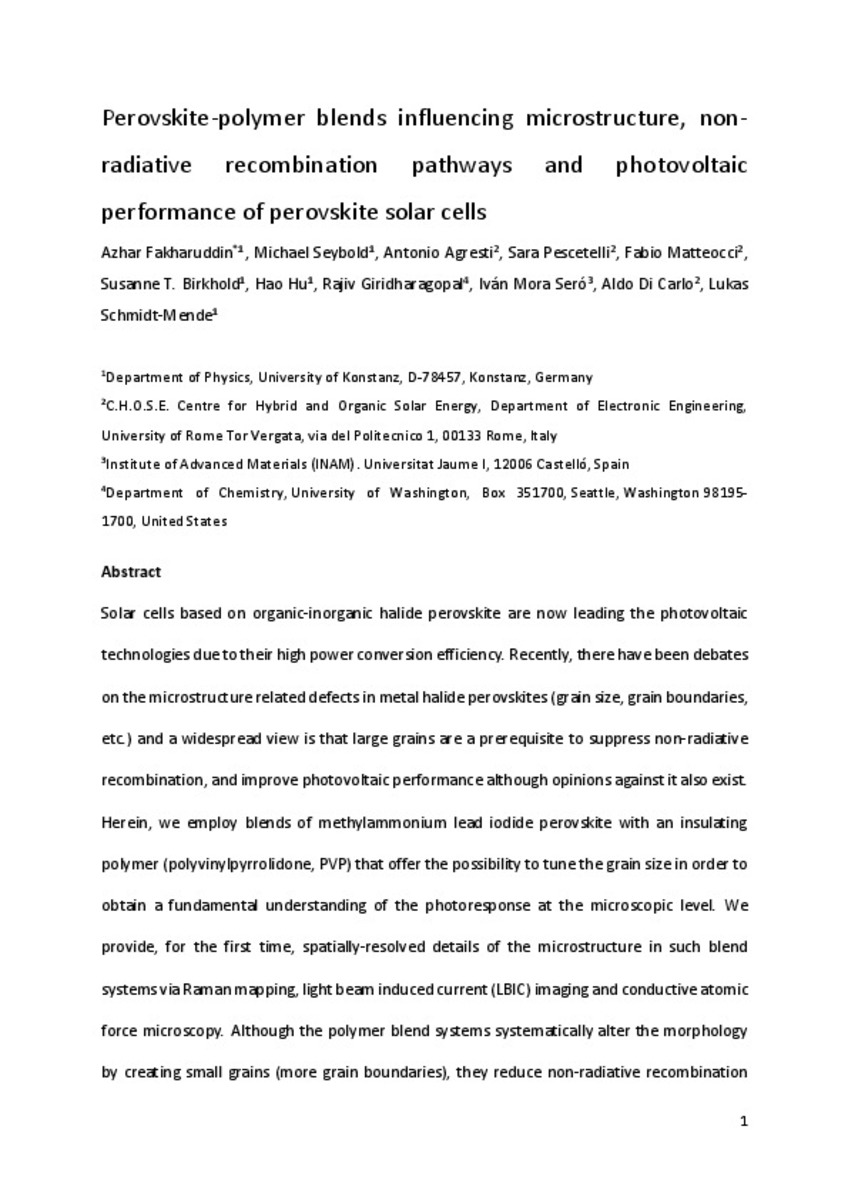Mostrar el registro sencillo del ítem
Perovskite-Polymer Blends Influencing Microstructures, Nonradiative Recombination Pathways, and Photovoltaic Performance of Perovskite Solar Cells
| dc.contributor.author | Fakharuddin, Azhar | |
| dc.contributor.author | Seybold, Michael | |
| dc.contributor.author | Agresti, Antonio | |
| dc.contributor.author | Pescetelli, Sara | |
| dc.contributor.author | matteocci, fabio | |
| dc.contributor.author | Haider, Muhammad Irfan | |
| dc.contributor.author | Birkhold, Susanne T. | |
| dc.contributor.author | Hu, Hao | |
| dc.contributor.author | Giridharagopal, Rajiv | |
| dc.contributor.author | Sultan, Muhammad | |
| dc.contributor.author | Mora-Sero, Ivan | |
| dc.contributor.author | Di Carlo, Aldo | |
| dc.contributor.author | Schmidt-Mende, Lukas | |
| dc.date.accessioned | 2018-12-05T08:43:20Z | |
| dc.date.available | 2018-12-05T08:43:20Z | |
| dc.date.issued | 2018 | |
| dc.identifier.citation | FAKHARUDDIN, Azhar, et al. Perovskite-polymer blends influencing microstructure, non-radiative recombination pathways and photovoltaic performance of perovskite solar cells. ACS applied materials & interfaces, 2018, 10, 49, 42542–42551 | ca_CA |
| dc.identifier.issn | 1944-8244 | |
| dc.identifier.issn | 1944-8252 | |
| dc.identifier.uri | http://hdl.handle.net/10234/177890 | |
| dc.description.abstract | Solar cells based on organic–inorganic halide perovskites are now leading the photovoltaic technologies because of their high power conversion efficiency. Recently, there have been debates on the microstructure-related defects in metal halide perovskites (grain size, grain boundaries, etc.) and a widespread view is that large grains are a prerequisite to suppress nonradiative recombination and improve photovoltaic performance, although opinions against it also exist. Herein, we employ blends of methylammonium lead iodide perovskites with an insulating polymer (polyvinylpyrrolidone) that offer the possibility to tune the grain size in order to obtain a fundamental understanding of the photoresponse at the microscopic level. We provide, for the first time, spatially resolved details of the microstructures in such blend systems via Raman mapping, light beam-induced current imaging, and conductive atomic force microscopy. Although the polymer blend systems systematically alter the morphology by creating small grains (more grain boundaries), they reduce nonradiative recombination within the film and enhance its spatial homogeneity of radiative recombination. We attribute this to a reduction in the density of bulk trap states, as evidenced by an order of magnitude higher photoluminescence intensity and a significantly higher open-circuit voltage when the polymer is incorporated into the perovskite films. The solar cells employing blend systems also show nearly hysteresis-free power conversion efficiency ∼17.5%, as well as a remarkable shelf-life stability over 100 days. | ca_CA |
| dc.format.extent | 10 p. | ca_CA |
| dc.language.iso | eng | ca_CA |
| dc.publisher | American Chemical Society | ca_CA |
| dc.relation.isPartOf | ACS Applied Materials and Interfaces, 2018, 10, 49, 42542–42551 | ca_CA |
| dc.rights | Copyright © American Chemical Society | ca_CA |
| dc.rights.uri | http://rightsstatements.org/vocab/InC/1.0/ | * |
| dc.subject | defects in perovskites | ca_CA |
| dc.subject | grain boundaries and defects | ca_CA |
| dc.subject | non-radiative recombination | ca_CA |
| dc.subject | polymer scaffolds for perovskites | ca_CA |
| dc.subject | spatially resolved characterizations of perovskites | ca_CA |
| dc.title | Perovskite-Polymer Blends Influencing Microstructures, Nonradiative Recombination Pathways, and Photovoltaic Performance of Perovskite Solar Cells | ca_CA |
| dc.type | info:eu-repo/semantics/article | ca_CA |
| dc.identifier.doi | https://doi.org/10.1021/acsami.8b18200 | |
| dc.relation.projectID | Alexander von Humboldt; the ERANET project Hydrosol; Deutsche Forschungsgemeinschaft DFG for funding within the framework of the Collaborative Research Center SFB-1214 - project Z1 (Particle Analysis Center); Carl Zeiss Foundation; DOE (DE-SC0013957) ;European Research Council (ERC) via a Consolidator Grant (724424-No- LIMIT). | |
| dc.rights.accessRights | info:eu-repo/semantics/openAccess | ca_CA |
| dc.relation.publisherVersion | https://pubs.acs.org/doi/full/10.1021/acsami.8b18200 | ca_CA |
| dc.contributor.funder | A.F. acknowledges financial support from Alexander von Humboldt and A.F. and L.S.M. from the ERANET project Hydrosol. The authors thank the Deutsche Forschungsgemeinschaft DFG for funding within the framework of the Collaborative Research Center SFB-1214 - project Z1 (Particle Analysis Center). S.T.B. acknowledges financial support from the Carl Zeiss Foundation. We thank David S. Ginger (University of Washington) for the use of AFM facilities for cAFM measurements. R.G. acknowledges support from DOE (DE-SC0013957). IMS acknowledges European Research Council (ERC) via a Consolidator Grant (724424-NoLIMIT). | |
| dc.type.version | info:eu-repo/semantics/acceptedVersion | ca_CA |
Ficheros en el ítem
Este ítem aparece en la(s) siguiente(s) colección(ones)
-
INAM_Articles [517]









